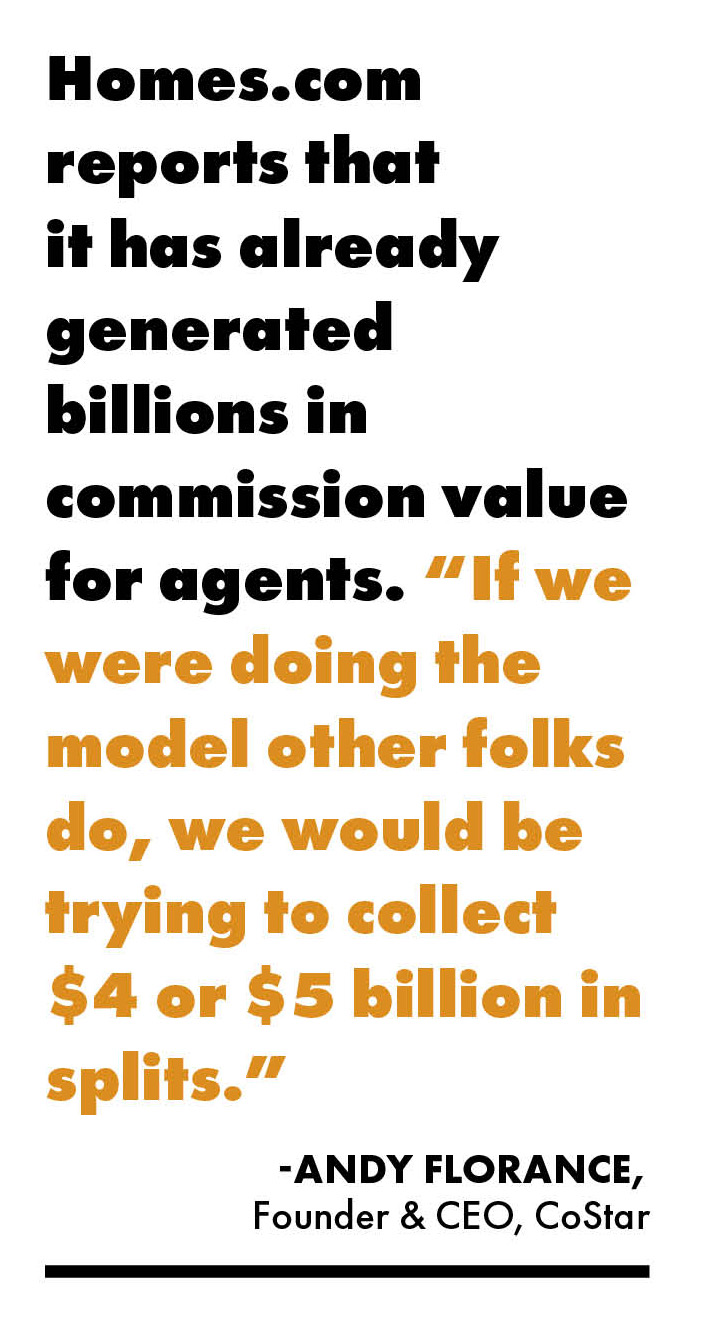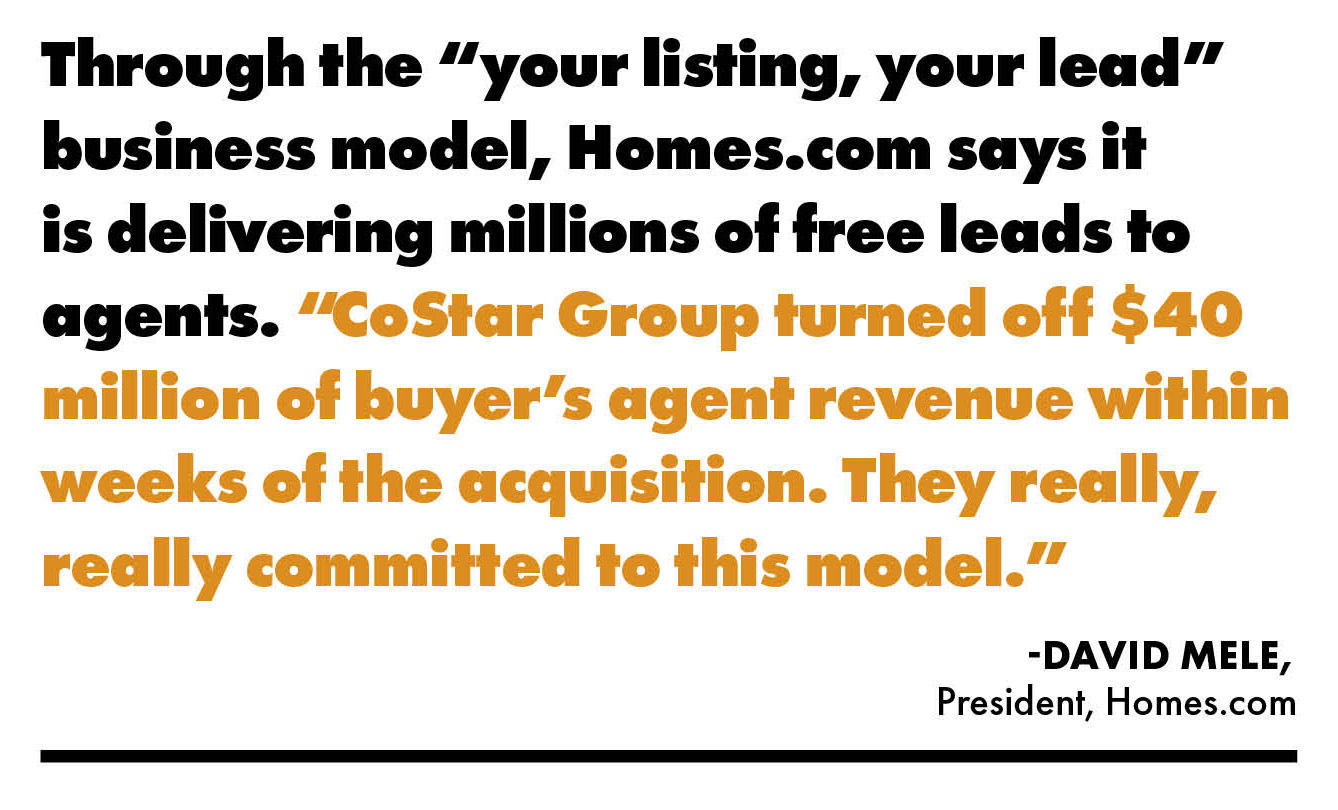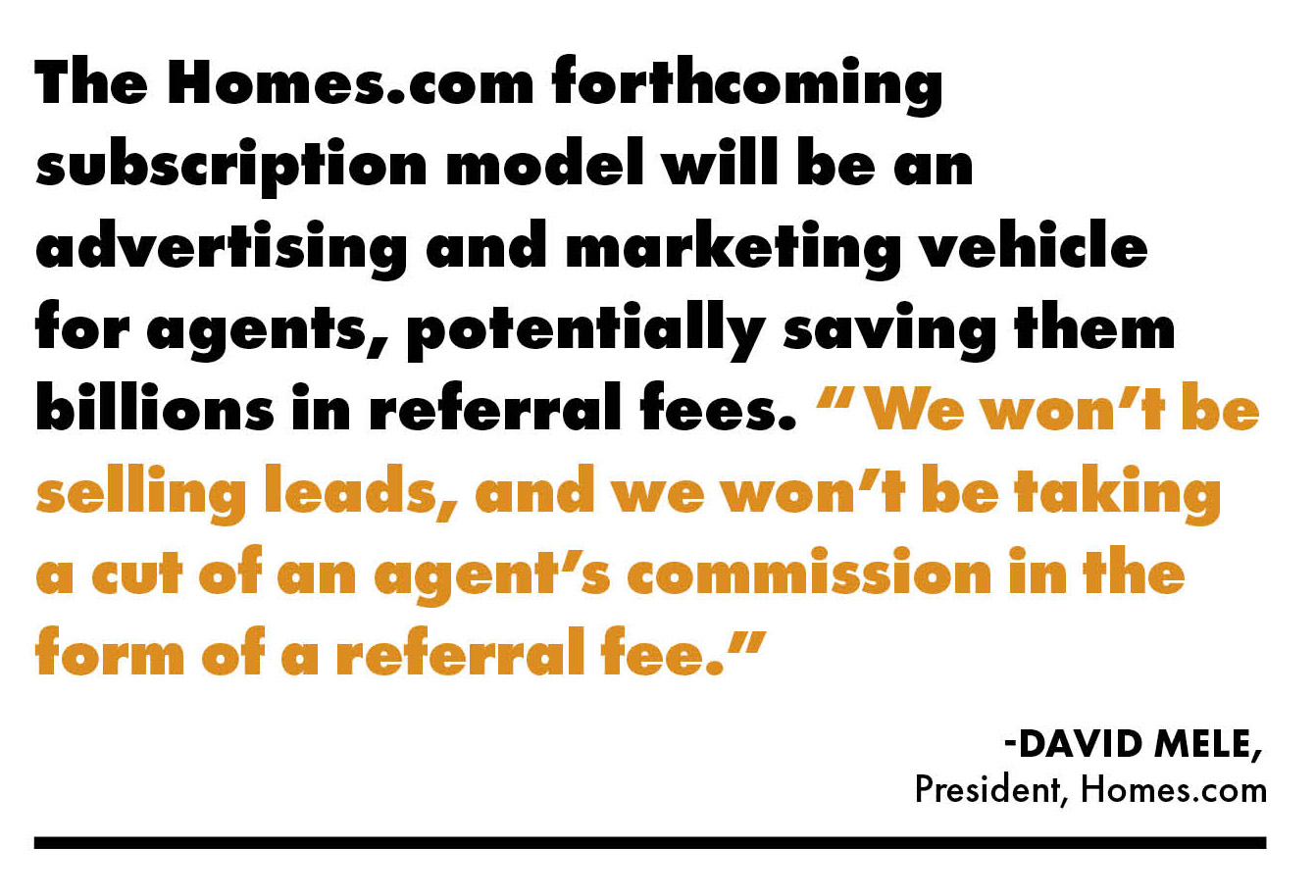When CoStar Group acquired Homes.com in 2021, the goal was bold and ambitious: to earn the coveted No. 1 spot in the portal field by creating the best environment for real estate professionals and consumers. Nearly three years later, Homes.com has gained important ground toward that goal, recently claiming the No. 2 spot by surpassing 100 million unique monthly visitors in September. The portal has jumped ahead of realtor.com® and Redfin, and now stands second only to Zillow. Along with this exponential jump in traffic, Homes.com has generated billions of dollars in commissions for agents.

CoStar Group Founder & CEO Andy Florance share insights on the portal landscape at RISMedia’s CEO & Leadership Exchange in September.
Unsurprisingly, the rapid pace of Homes.com’s growth has left some questioning the legitimacy of the numbers. Even CoStar Group Founder & Chief Executive Officer Andy Florance refers to the site’s jaw-dropping 1,290% growth as “silly numbers.” Yet he says reaching the milestone was a simple matter of “blocking and tackling and doing the right moves.” With a wealth of experience and a deep talent bench, this is simply what CoStar is accustomed to.
Still, shortly after Homes.com announced its 100 million-visitors milestone in October, the competition got busy debunking the metrics, casting doubt on Homes.com’s claim to the No. 2 spot. By unpacking the methodology, however, Homes.com President David Mele says that the results are crystal clear.

According to Mele, it’s imperative to look at where the data is coming from. “We have to focus on the source of the traffic number that we are communicating,” he explains, “and what we’re communicating is the actual measured number of unique visitors, server side, for Homes.com measured through Google Analytics. We’re talking about actual measured traffic that came to Homes.com in September.”
Conversely, competitive portals disputing Homes.com’s numbers are referencing metrics from third-party reporting sites, says Mele. “They’ll either have a panel or a sample, and then they will extrapolate to get to total traffic numbers,” he explains. “We have competitors pointing to third-party reporting that is not actual traffic, but estimated traffic. That’s a really important distinction.”
Getting to 100M: The CoStar Playbook
Accepting that September’s 100 million unique monthly visitors to Homes.com is valid, the question becomes, how’d they do it? The short answer? This is not CoStar Group’s first rodeo.
“We’ve done this before,” says Florance. “When we acquired LoopNet, we increased traffic 400%. When we acquired Land.com, we dramatically increased their traffic. When we bought Apartments.com, it was behind ForRent, it was behind Apartment Finder, it was behind Apartment Guide. It was behind Rent.com. It was behind Zillow and it was behind Craigslist. And over the course of two years, we worked on providing high-quality content and a better UX. We focused on SEO, SEM brand building, and we grew the Apartments.com traffic fivefold, then tenfold, and became the No. 1 player.”
So it was no surprise, therefore, that Florance and his team would embark on the same mission in the residential portal space, making it the “single highest priority” for the company over the last 18 months.
“I think it’s the continuation of applying the levers,” says Mele. “Certainly a big one is that we have a lot of experience with targeted digital marketing, and we’re seeing that experience pay off in terms of traffic generation, but that’s not enough. You have to deliver a great user experience when you get someone to the site to really deliver traffic at that level.”
Mele refers to the plan as the “CoStar playbook,” and describes its three pillars:
1 PRODUCT. “We have invested heavily in a complete redesign and rebuild of Homes.com,” says Mele, calling the site clean, uncluttered and easy to navigate. This appealing interface is married with the Homes.com “your listing, your lead” philosophy to deliver a better environment for marketing listings.
“Consumers can easily identify and directly connect to the person who knows the most about a home. And that’s the listing agent,” says Mele. “No other major portal does that. Instead, they try to capture a home searcher and then connect them to a potential buyer’s agent—who likely has never set foot in the home and may have never sold a home in that neighborhood. There’s this misdirection that takes place on our competitors’ sites. We want to be really transparent with a consumer—you’re looking for information about a home, and we’re going to connect you to the person who knows the most about the home. And that’s the listing agent.”
2 CONTENT. Homes.com’s years of experience in the portal space has taught them that homebuyers are not just looking for a house—they’re looking for a community. To that end, CoStar has invested heavily in building an in-house team to develop volumes of unique, compelling and proprietary content that helps a home searcher understand the community in which a house is located. A profusion of details—schools, parks, shopping, nightlife, transportation, commute times, walkability, etc.—is presented in one convenient and simplified package on Homes.com. “We’re rolling out tens of thousands of comprehensive neighborhood guides,” says Mele.
3 MARKETING. Great product and great content alone, however, are not enough. CoStar Group’s marketing acumen serves as the essential third pillar of the playbook.
“We’re applying the marketing experience and expertise that powered LoopNet and Apartments.com to the number one positions in their markets,” says Mele. “We’re in chapter one of the marketing playbook, and already that has propelled us into this number two position. Right now, it’s really been targeted digital marketing. What will soon come is a very large-scale consumer advertising campaign.”

Some of the portal environment’s biggest players took the stage at RISMedia’s CEO & Leadership Exchange to discuss how portals are changing the real estate playing field. Homes.com President David Mele (middle), leads the conversation with panelists Mehul Patel (left) – Constellation1 VP of product and technology – and Curt Beardsley (right) – VP of industry development at Zillow.
Doubling down on ‘Your listing, your lead’
“Your listing, your lead” was the Homes.com battle cry long before CoStar Group entered its orbit. According to Florance, this defining premise clearly delineates Homes.com from other portals by directly connecting consumers interested in a particular property to that property’s listing agent—a “clean experience” as he describes it.
“Consumers know that if they are interested in a particular home and they want to learn more about it, the listing agent knows more than anybody else,” he explains. “When you go to our site, you get connected to the listing agent. When you go to other sites, you get connected to a pool of buyer brokers who want to get your business for buyer-broker representation. They don’t know anything about the particular house you’re emotionally engaged in right now.”
According to Mele, CoStar Group “put its money where its mouth is” to support the “your listing, your lead” business model. “CoStar Group turned off $40 million of buyer’s agent revenue within weeks of the acquisition,” he says. “They really, really committed to this model, and the reason is, we believe it’s better for the consumer.”

Florance concurs, saying that the approach is “fundamentally what we believe in.” It’s also the clear path to profitability.
“We believe it’s better to be in harmony with your paying customers rather than to be semi in competition with them,” he explains. “And we believe that focusing on the listings, and helping people with listings get the best value for their sellers, is the most important thing to do. And we feel that the evidence is clear that companies that do ‘your listing, your lead’ are very successful, and people that do the buyer broker, lead generation commission split are not successful. Take Zillow; in the past 10 years, they’ve never had a profitable year, and they have cumulative losses of $1.7 billion.”
Beyond the favorable economics of “your listing, your lead,” the model also lends itself to the potential future landscape of residential real estate in the aftermath of the commission-focused lawsuits. “If you’re not doing ‘your listing, your lead,’ you are 100% reliant on the buyer broker commission rule,” explains Florance. “If people abandon that forced-commission payment to the buyer agent, my belief is that those business models evaporate overnight and they’re back to ground zero. The tack we took was less controversial and more harmonious with the industry. When a change comes, we’re more sustainable.”
Ultimately, the proof is in the pudding, in this case, the millions of leads currently flowing through Homes.com.
“We’re generating more leads than many of the other sites because it’s easier to generate leads if you’re not trying to take 40% of the value of the lead,” says Florance. “If you’re just connecting people directly, there’s no friction.”
Florance estimates that Homes.com (at press time) had generated at least $12 billion in commission value for agents. Not only does he believe that number to be “growing dramatically,” he emphasizes that it flies in the face of the exorbitant referral fees charged by other portals.
“If we were doing the model other folks do, we would be trying to collect $4 or $5 billion in splits,” says Florance. “We’re not doing that. We’re getting hyper growth because it’s super-low friction, a really clean interface and a super-fast site. It’s working.”
A place for buyer’s agents
Mele admits that Homes.com does receive some knocks from competitors who point out that there’s more to the site than listing agents. And there is, indeed, a place for buyer’s agents on Homes.com.
“We strongly support the fact that homebuyers and sellers should be working with an experienced, professional advisor and a real estate agent, so there are multiple ways for a buyer’s agent to get value from Homes.com,” says Mele.
One way is by providing transparent access to a searchable, sortable agent directory where the consumer has total control, stresses Mele. During the home search, for example, if a consumer has a question, they can contact a listing agent. Or, if they’re already working with a buyer’s agent, they can make that connection on Homes.com, and that will be the only agent to show up on listings across the site. Their entire experience on Homes.com will display only the consumer’s connected agent.
“If you’re not represented and want to be, we have great tools, like our agent directory,” says Mele. “You’re in control to find the best agent for your criteria. You can see what neighborhoods they’ve worked in, their years of experience, etc. All of that is in our searchable agent directory.”
Less junk, more data
While some portals aspire to become everything to everyone, Homes.com has narrowed the focus to serve the specific needs of the home-buying consumer. For Florance, it’s a significant philosophical difference.
“Consumers are super straightforward,” he says. “They want to browse homes in their target neighborhoods and find the right properties. They want beautiful imagery. They want a fast-performing site. You have to optimize for that thing that 98% of people are doing on the platform. You see people trying to monetize with programmatic advertising. You see people trying to monetize mortgages. You see people trying to monetize anything and everything. And every time you do that, you’re throwing friction in the process. It distracts you from the primary goal, which is helping people sell homes online. That’s the primary goal.”
Florance’s decades of experience in the digital space has taught him that programmatic advertising is an exercise in “negative marketing dollars.”
“When you start putting a lot of junk on the site, whether it be your own company’s junk or another company’s junk, it’s all negative marketing dollars,” he explains. “It actually causes you to lose unique visitors. It causes you to slow performance and it distracts people from what they’re there to do.”
What isn’t “junk,” however, is the wealth of pertinent data for homebuyers that Homes.com provides. Florance paints a helpful analogy: “If I add an oboe to a symphony, it’s not junk. It’s actually enhancing the symphony,” he explains. “So when we do things like school data, neighborhood data, park data or blogs, that’s actually coherent with the consumer experience on the site and actually strengthens the draw to the site.”
As Florance explains, collecting data that is hugely relevant yet not readily available is embedded in CoStar’s DNA. “We are unique, and we’re not afraid to hire a lot of people to go chase down data that requires getting your hands dirty,” he says, “We’ve got about a thousand people right now working on Homes.com, and hundreds and hundreds of people collecting content that doesn’t come from the MLS or CoreLogic or any of these other things.”
Florance and Mele believe the collection and distribution of such data is supremely important. If Homes.com can help homebuyers assess and understand a community, that’s a win for all involved. “We are not just surfing on the coattails of the MLSs,” says Florance. “We’re thoughtfully trying to enhance the kind of content that’s available to buyers.”

Next Stop, No. 1
The marketing strategy that has helped Homes.com secure the No. 2 position is just the tip of the iceberg, according to Mele and Florance.
“The fun thing is, we are nowhere near done,” says Florance. “We haven’t released half the stuff we plan to release.”
One of those releases, targeted for Q2 2024, is the Homes.com subscription model. While Mele reserves the right to withhold details, he does share what the subscription model won’t be: “We won’t be selling leads, and we won’t be taking a cut of an agent’s commission in the form of a referral fee,” the dominant revenue model for today’s portals, he explains. What Homes.com plans to offer instead is an advertising and marketing model that will allow agents to promote and boost their listings.
“But we also know that agents don’t always have listings, or when they have listings, they still want to acquire additional clients,” Mele adds. “So we will also allow agents to boost and promote themselves on Homes.com.”
The strategy speaks directly to Florance’s belief that Homes.com’s ultimate success will only happen if the upside is shared with real estate professionals and their consumers. “It’s not about us extracting every last penny, but about us being able to provide value, recognize value for our investors, and being in harmony with agents and buyers,” he says.
And that is ultimately how Homes.com intends to surpass Zillow and claim the No. 1 spot in real estate portal traffic.
“We’ll deliver an experience that’s preferred by consumers and preferred by agents,” says Mele. “Those are our two north stars every day for everything that we do. Then we’ll apply our experience in growing traffic and building brands to propel ourselves to the number one spot.”
RISMedia Senior Editor Jesse Williams contributed to this article.
For more information, please visit www.homes.com.





